Electric Vehicle Usage Statistics and Facts (2025)

Updated · Apr 09, 2025


TABLE OF CONTENTS
Introduction
Electric Vehicle Usage Statistics: Electric vehicles (EVs) have experienced significant global adoption, with approximately 40 million electric cars in use by 2023. In that year, nearly 14 million new electric cars were registered worldwide, marking a 35% increase from the previous year. China led this growth, accounting for 60% of global EV sales, followed by Europe and the United States.
In the United States, EV sales reached approximately 1.7 million units in 2024, reflecting a 21% increase from 2023 and representing 10.2% of global new EV registrations. Projections indicate that global EV sales will surpass 20 million units in 2025, driven by policy support and consumer interest. Countries like Norway have achieved remarkable penetration rates, with EVs constituting 91.6% of new car sales in 2024. These figures underscore the accelerating shift towards electric mobility worldwide.
Editor’s Choice
- There are currently 2,442,270 electric vehicles registered across the U.S.
- California has the highest rate of EV use, with 2.5% of all vehicles being electric.
- Electric Vehicle Usage Statistics stated that Tesla dominates the U.S. EV market, holding a 56.5% share of all-electric cars sold.
- In 2023, the value of the electric vehicle market in the U.S. was around $49.1 billion.
- About 38% of U.S. adults say they would consider buying an electric car for their next vehicle purchase.
- If a Level 2 charger is used, most new electric cars will need up to 12 hours to charge fully.
- As of 2023, about 23% of people in the U.S. prefer electric cars over gas-powered ones.
- The global electric vehicle market is expected to grow and hit 17.07 million units by 2028.
- In 2023, Tesla’s Model Y was the top-selling electric car in the U.S., with around 403,700 units sold.
- A report by Our World in Data shows that Norway had the highest rate of electric car sales, with 93% of all cars sold in the country being electric.
- Most of the world’s biggest EV makers are based in China, which produces 406,528 megawatt-hours of battery power. South Korea ranks second, followed by Japan in third place.
- In the U.S., electric vehicle sales rose by 60% from 2022 to 2023, reaching 1.6 million units sold.
- Australia was the top lithium producer last year, with 86,000 metric tons mined.
- Electric Vehicle Usage Statistics stated that around 77% of people would consider buying an electric vehicle, mainly to save fuel.
- According to the 2024 Worldwide EV Stats, the electric vehicle market is expected to reach $623.3 billion.
Electric Vehicles Regional Statistics
#1. APAC EV Statistics
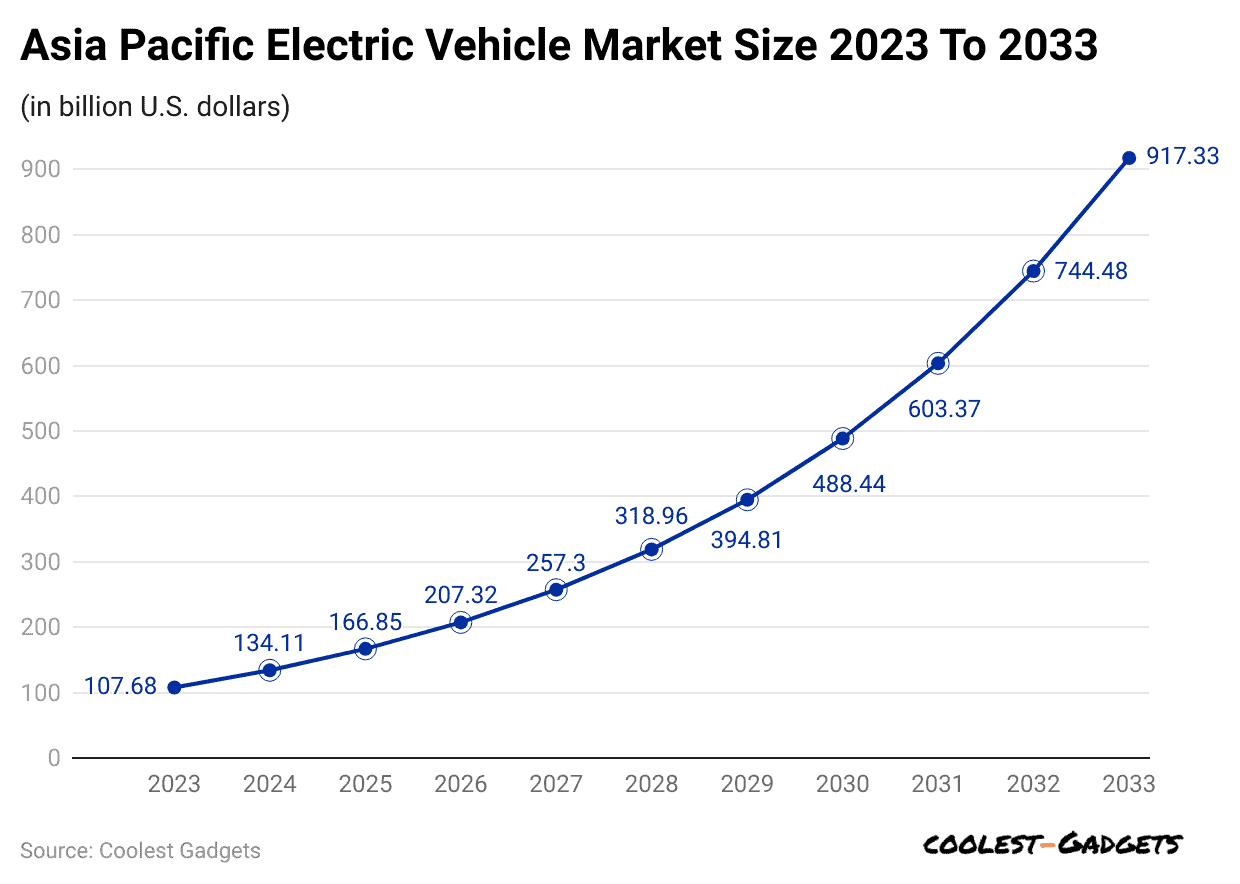 (Reference: precedenceresearch.com)
(Reference: precedenceresearch.com)
- The electric vehicle market is expected to bring in about $407.6 billion in revenue in 2025.
- The market is predicted to grow at an average yearly rate of 2.81% from 2025 to 2029, which could push its total value up to around $455.4 billion by 2029.
- The number of EVs sold is expected to hit 10.24 million units by 2029.
- In 2025, the average cost of an electric vehicle is expected to be close to $47,200.
- When looking at countries, China is expected to make the most money from EVs, with projected earnings of about $377 billion in 2025.
#2. EMEA EV Statistics
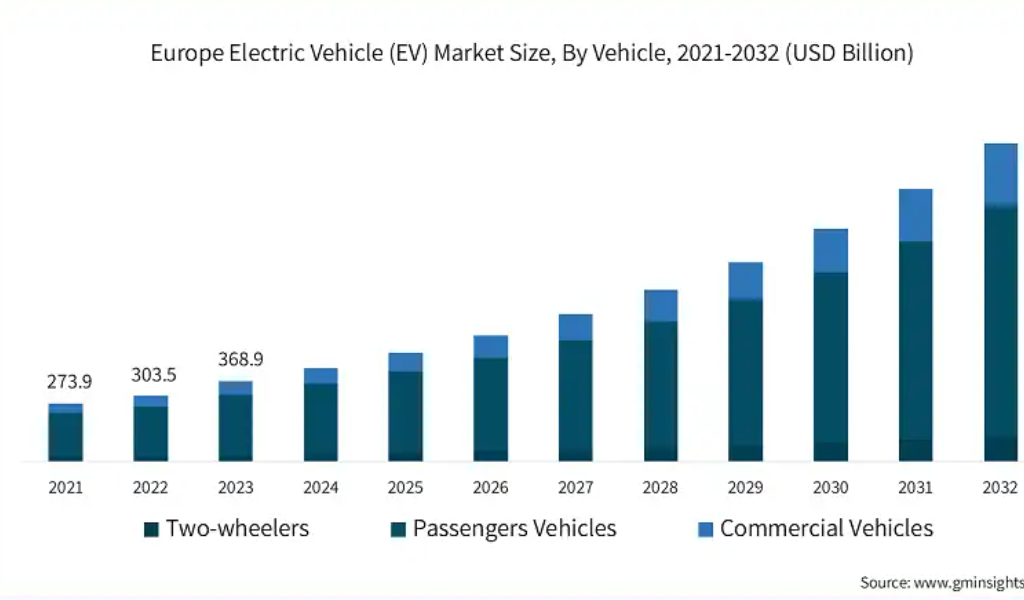 (Source: gminsights.com)
(Source: gminsights.com)
- Electric Vehicle Usage Statistics stated that the electric vehicle (EV) market is expected to bring in around $231.6 billion in revenue by 2025.
- Experts predict that the market will grow steadily at a rate of 7.43% annually from 2025 to 2029, reaching approximately $308.5 billion by the end of the period.
- It’s estimated that around 4.43 million EVs will be sold by 2029. In 2025, the average price of an electric vehicle is expected to be around $69,500.
- Looking at the global picture, China is expected to generate the highest revenue in the EV market, with about $377 billion in 2025.
#3. LATAM EV Statistics
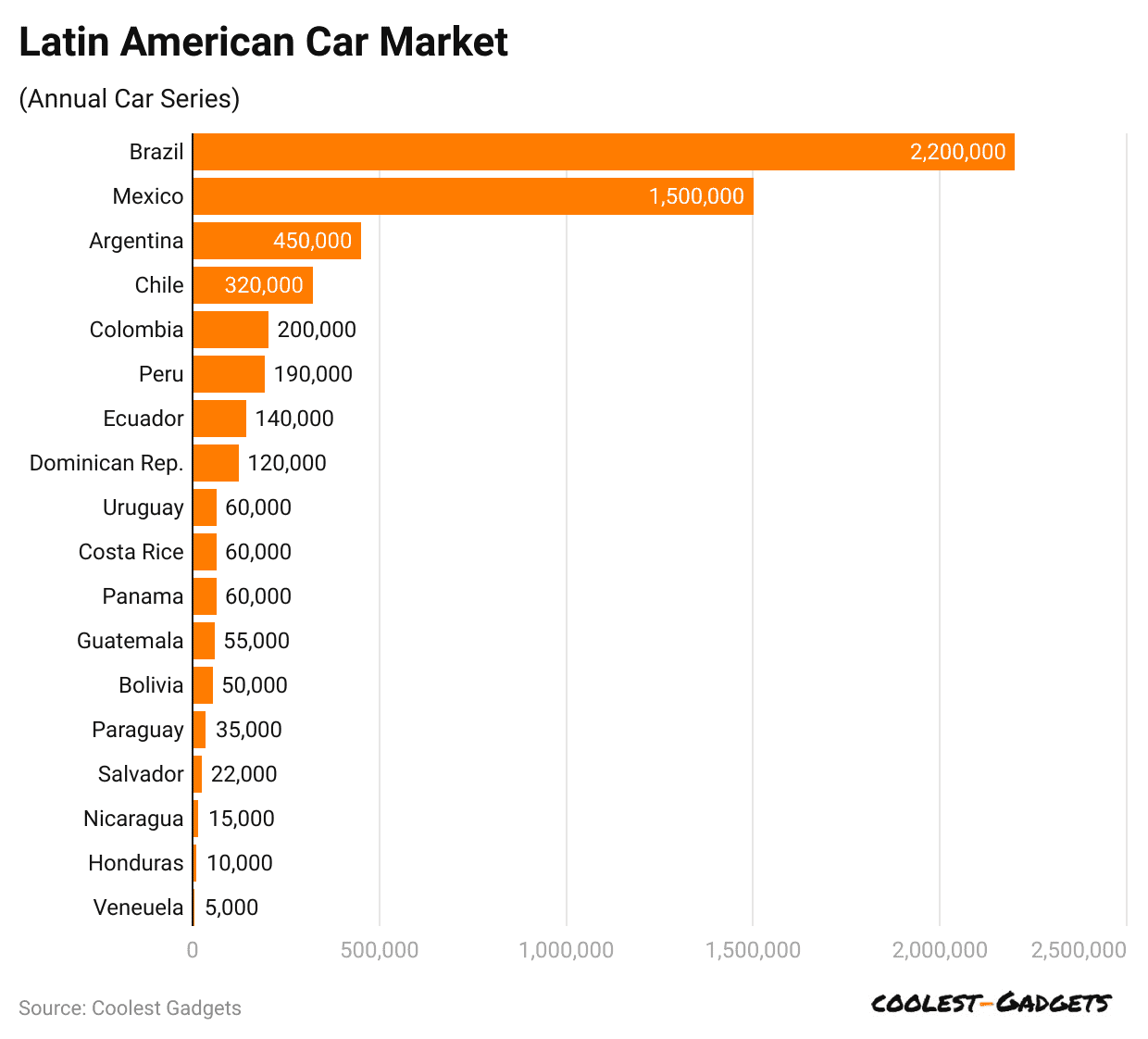 (Reference: cleantechnica.com)
(Reference: cleantechnica.com)
- The electric vehicle (EV) industry is expected to earn $40.6 billion in 2025 and grow by about 10.24% per year from 2025 to 2029.
- By 2029, the market could reach around $60 billion.
- Experts estimate that about 144,150 EVs will be sold by then. In 2025, the average cost of an electric vehicle in this market is expected to be nearly $409,900.
- Looking at the global market, China is forecasted to make the most money from EV sales, with a projected revenue of around $377 billion in 2025.
#4. MENA EV Statistics
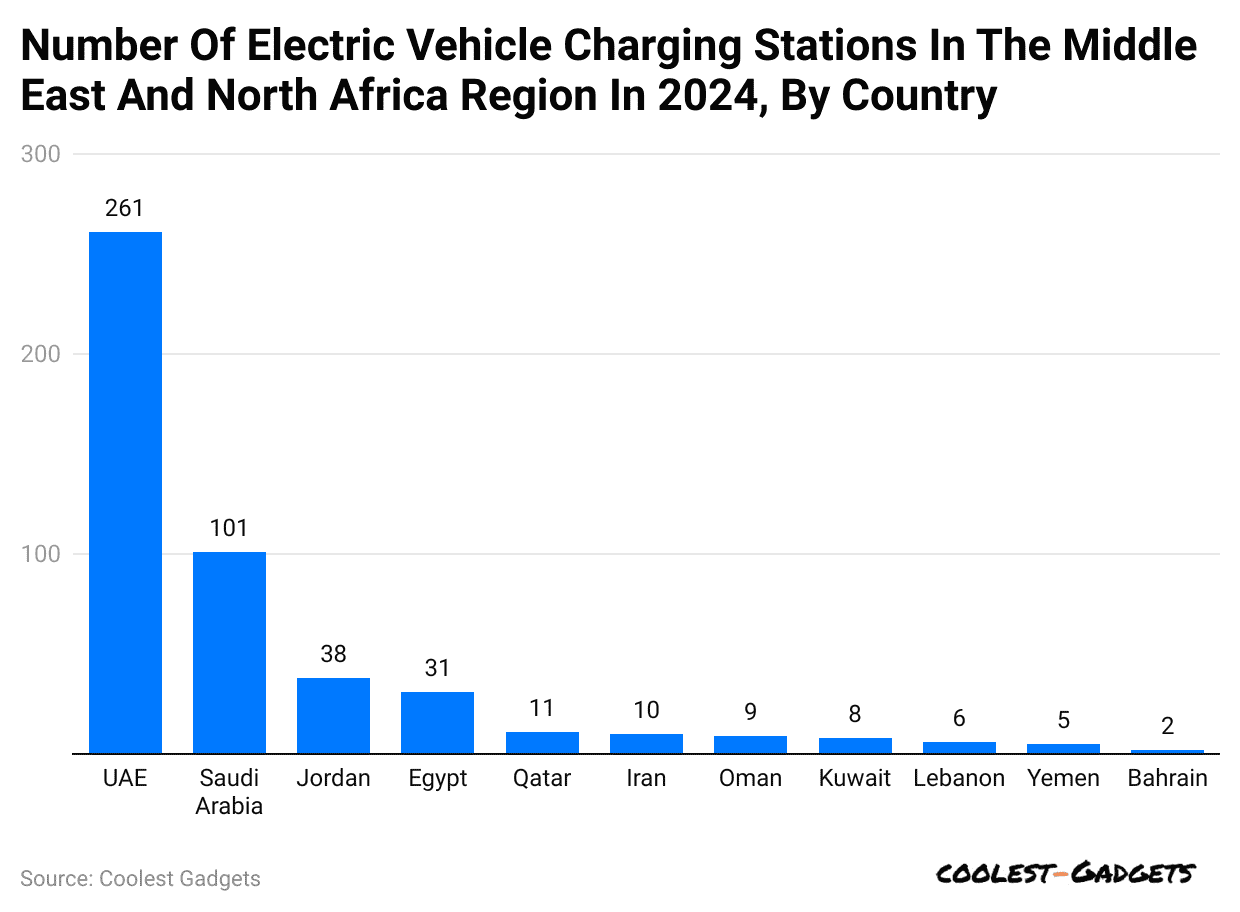 (Reference: statista.com)
(Reference: statista.com)
- The electric vehicle (EV) market is expected to bring in $14.6 billion in revenue in 2025.
- According to Electric Vehicle Usage Statistics, the market is projected to grow at an average annual rate of 6.67% over the next five years, from 2025 to 2029, reaching approximately $18.9 billion by 2029.
- By then, about 260,590 EV units are expected to be sold. The average price of an electric car in 2025 will be about $70,600.
- Looking at the global market, China is expected to earn the highest revenue from EVs, reaching about $377 billion in 2025.
Development of EV and Changing Technology
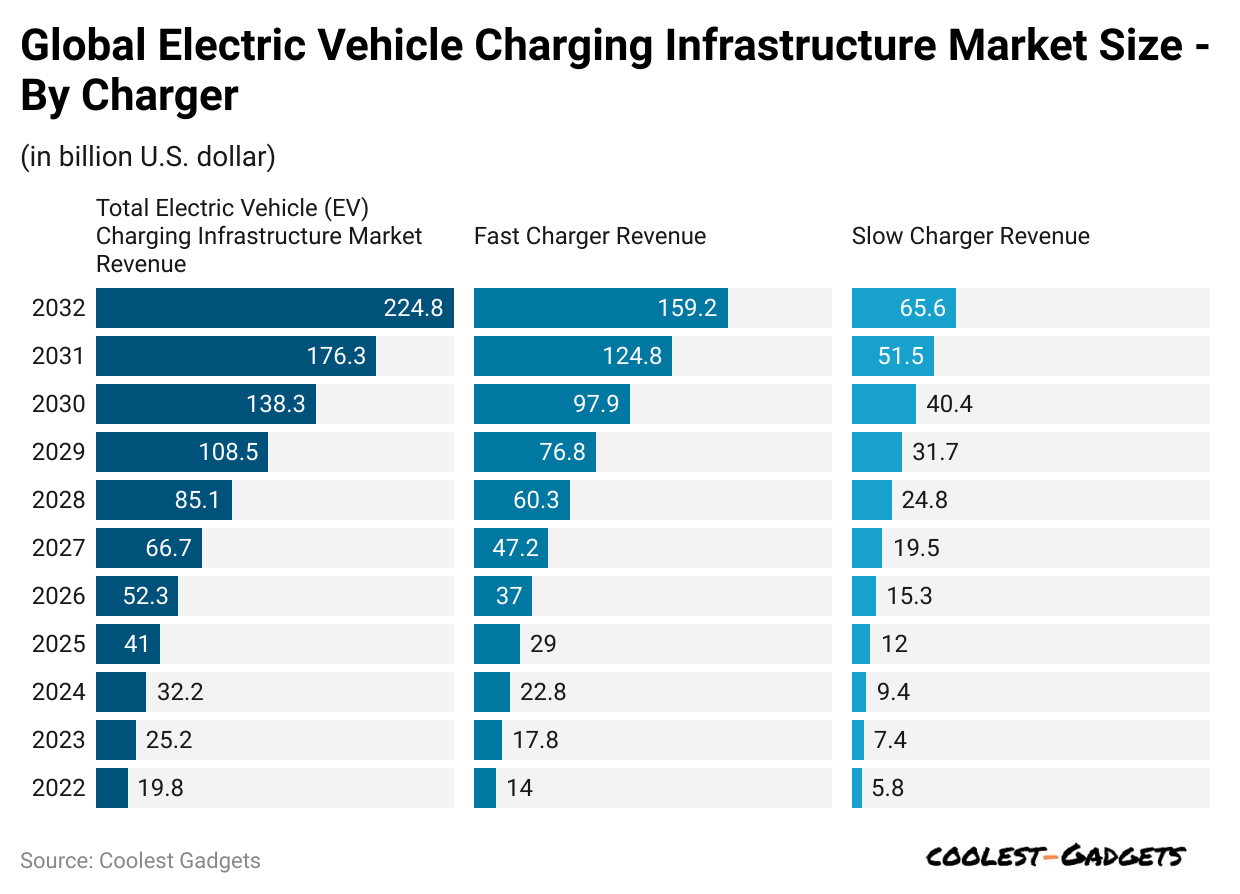 (Reference: scoop.market.us)
(Reference: scoop.market.us)
#1. Smart Charging for EVs
- Smart charging uses internet-connected charging systems and has become a common feature in the electric vehicle (EV) industry.
- It gives businesses and everyday users better control over electricity use, making charging more convenient and efficient.
#2. Vehicle-to-Grid (V2G) Technology
- V2G lets EVs back power to the electricity grid like stationary energy storage systems.
- Some companies already offer this service and sell V2G chargers. This market is projected to reach over €5 billion by 2024.
- Electric Vehicle Usage Statistics stated that the European standard ISO 15118-20, launched in 2020, sets the rules for this two-way charging.
- By 2030, about 75% of revenue from EV charging is predicted to come from energy management services.
- Virta is recognized as one of the top global players in V2G solutions.
#3. Plug and Charge Technology
- Plug and Charge makes EV charging much easier. Drivers plug in their car, and it automatically starts charging without using cards or apps.
- This technology is based on the ISO 15118 standard, which allows the vehicle to safely share its ID through the charging cable.
- Why it matters:
- Easy to Use: No need for apps or cards.
- Secure: Uses encrypted data for safety.
- Efficient: It speeds up charging and boosts customer satisfaction.
- Standardized: Makes it easier to match vehicles and chargers globally.
#4. Battery Demand and Production
- As more electric vehicles (EVs) hit the road, the demand for lithium-ion batteries has increased significantly.
- 2023 demand increased by 40%, primarily driven by the rise in battery-electric (BEVs) and plug-in hybrid (PHEV) vehicles, which require larger batteries than regular hybrids.
#5. China’s Dominance
- China leads in battery manufacturing, particularly in the production of heavy-duty batteries.
- Approximately 12% of the batteries produced there are shipped overseas.
- China also accounts for approximately 90% of the world’s cathode material production and more than 97% of anode production.
- Electric Vehicle Usage Statistics stated that Korea and Japan follow but hold much smaller shares.
- Overproduction has enabled China to become the world’s largest exporter of battery cells and materials.
- Meanwhile, production in Europe and the U.S. grew 25% yearly.
#6. Price Drops
- Battery prices fell by nearly 14% in 2023 due to lower costs of key materials such as cobalt, graphite, and manganese.
- China remains the most cost-effective location for battery production, followed by North America and Europe.
#7. Future Innovation
- New battery designs, such as “cell-to-pack” and “cell-to-chassis,” are expected to enhance performance and energy density.
- Technologies like multi-layer electrodes may also lead to super-fast charging.
#8. Recycling Batteries
- With EVs ageing, battery recycling is becoming more important.
- Global recycling capacity reached 300 GWh in 2023 and is expected to increase to 1,500 GWh by 2030. This growth will support the eco-friendly reuse of EV batteries.
Environmental Impact of EVs
 (Source: iea.org)
(Source: iea.org)
#1. Electricity Usage
- In 2023, EVs used about 130 terawatt-hours of electricity — the same as Norway’s total consumption that year.
- By 2035, EVs might use 6–8% of the world’s power supply.
- Electric Vehicle Usage Statistics stated that smart charging and careful planning will be key to managing this extra demand.
#2. EVs as Energy Storage
- By the 2040s, EVs are expected to offer over 30 terawatt-hours storage capacity.
- This can help balance power grids, especially as more renewable energy is used.
- V2G tech lets EVs back power to the grid, helping during peak demand times.
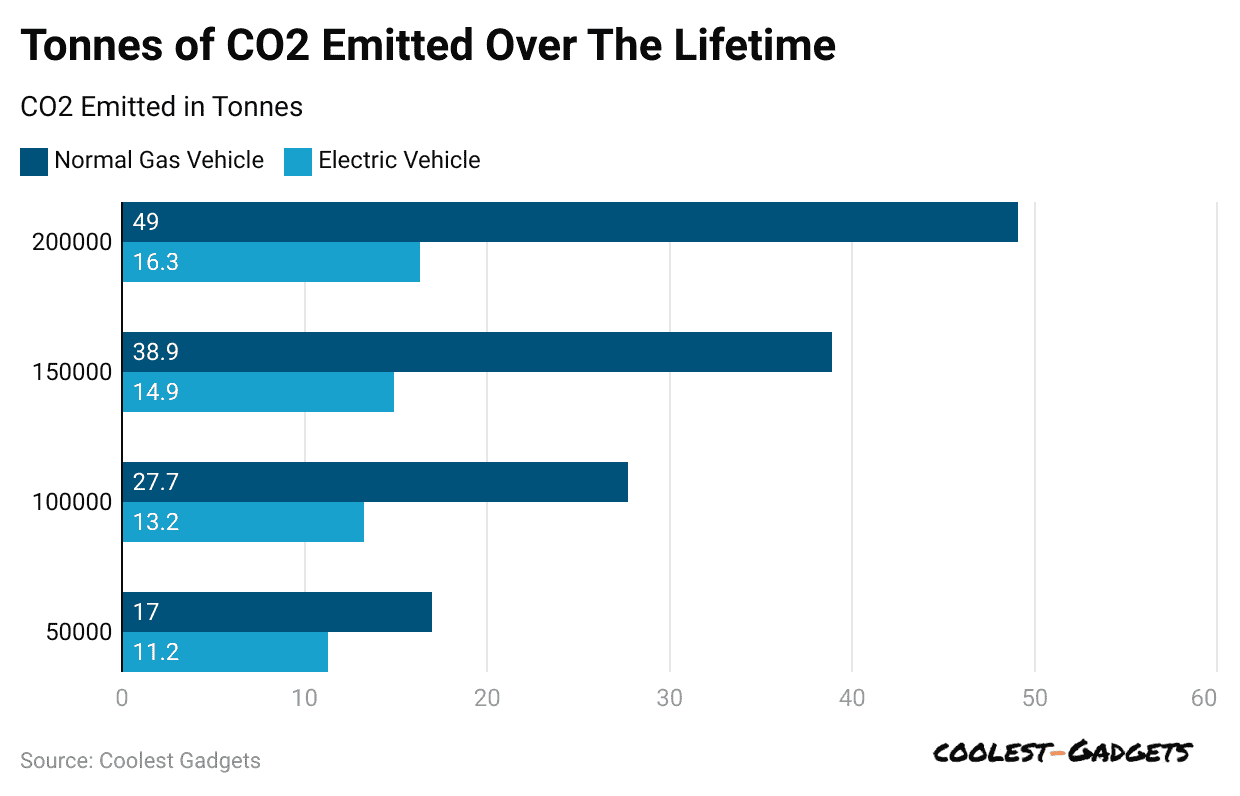 (Reference: scoop.market.us)
(Reference: scoop.market.us)
#3. Emission Reductions
- In 2023, EVs helped prevent more than 220 million metric tons of greenhouse gas emissions — a big jump from 80 million in 2022.
- Although EVs produce emissions during manufacturing, their lifetime emissions are about 50% less than gas-powered vehicles.
#4. Future Outlook
- By 2035, EVs could help cut 2 billion tons of CO2-equivalent emissions. That’s a huge step in fighting climate change.
#5. The SUV Challenge
- Electric Vehicle Usage Statistics stated that Electric SUVs require more materials and larger batteries, leading to about 70% more emissions during production than smaller EVs.
- If all-electric SUVs sold in 2023 had been mid-size cars instead, the world could have saved around 60 GWh of battery materials.
EV Policies Around the World
#1. Government Support
- Policies have played a big role in boosting EV adoption.
- Countries like the U.S., China, and Europe started by offering discounts and rebates to buyers.
- Now, they focus more on building charging stations and supporting electric trucks and buses.
#2. Case Study – United Kingdom
- Electric Vehicle Usage Statistics stated that the UK stopped offering EV purchase subsidies but invested £1.6 billion in public charging infrastructure.
- In 2023, over 53,000 chargers were installed. By 2030, the number is expected to reach 300,000.
#3. Global Targets
- Some nations plan to sell all new vehicles fully electric, while others aim to ban gas and diesel cars completely in the coming years.
- Rules are also being created to make EV charging easier, faster, and more accessible.
Electric Vehicles Usage in the United States Statistics
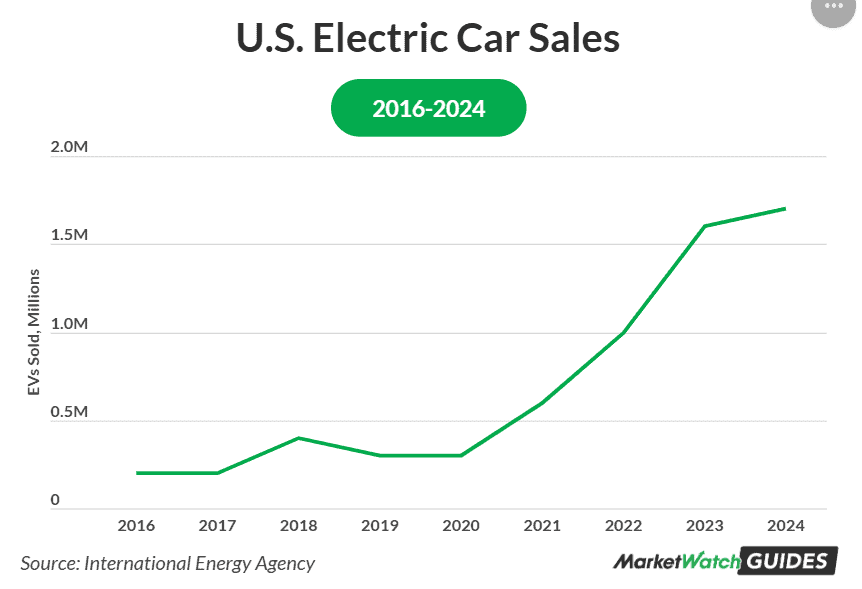 (Source: marketwatch.com)
(Source: marketwatch.com)
- Around 1.7 million electric vehicles (EVs) were sold in the U.S. in 2024, a 21% jump compared to the 1.4 million sold in 2023.
- In 2024, the U.S. made up 10.2% of all new EV registrations worldwide.
- China, Europe, and the U.S. are currently the top three regions leading the global EV market.
- In the U.S., there’s a strong push to grow local production, especially for EV batteries.
- The federal government has committed $23 billion in loans and grants through the Infrastructure Investment and Jobs Act (2021) and the Inflation Reduction Act (2022). These funds are focused on increasing EV and battery manufacturing across the country.
- Several carmakers have shared their plans to go green. For example:
-
- Jaguar aims to have a fully electric vehicle lineup by 2025.
- Mitsubishi targets 50% electrified vehicles by 2030 and plans to go 100% electric by 2035.
- Toyota wants 20% of its cars to be electric by 2026.
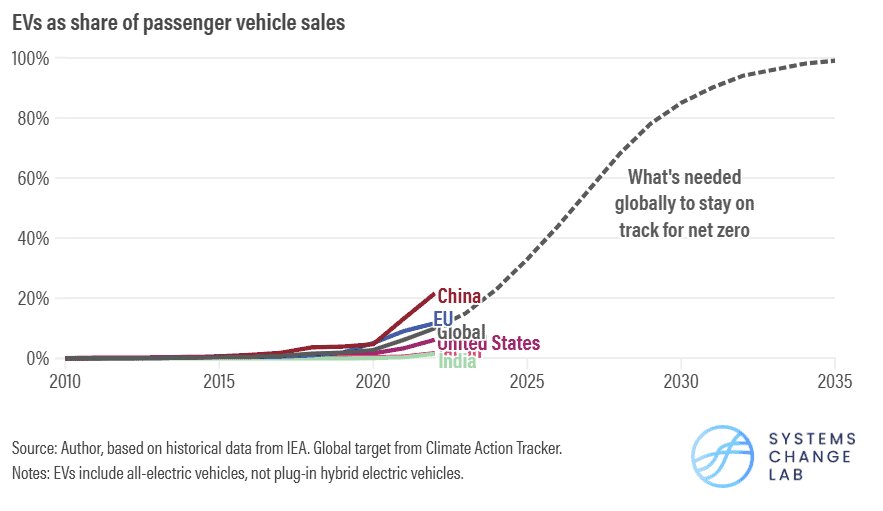 (Reference: wri.org)
(Reference: wri.org)
- Despite the momentum, some roadblocks remain, like supply chain issues and the rising or unpredictable prices of key materials needed for batteries.
- Still, the International Energy Agency (IEA) states that if EV adoption grows by 2030, electric cars could replace around 6 million barrels of oil per day.
Electric Vehicle Future Statistics
- According to data from Mordor Intelligence, the global electric vehicle market is expected to earn around $1.047 trillion in revenue by 2026.
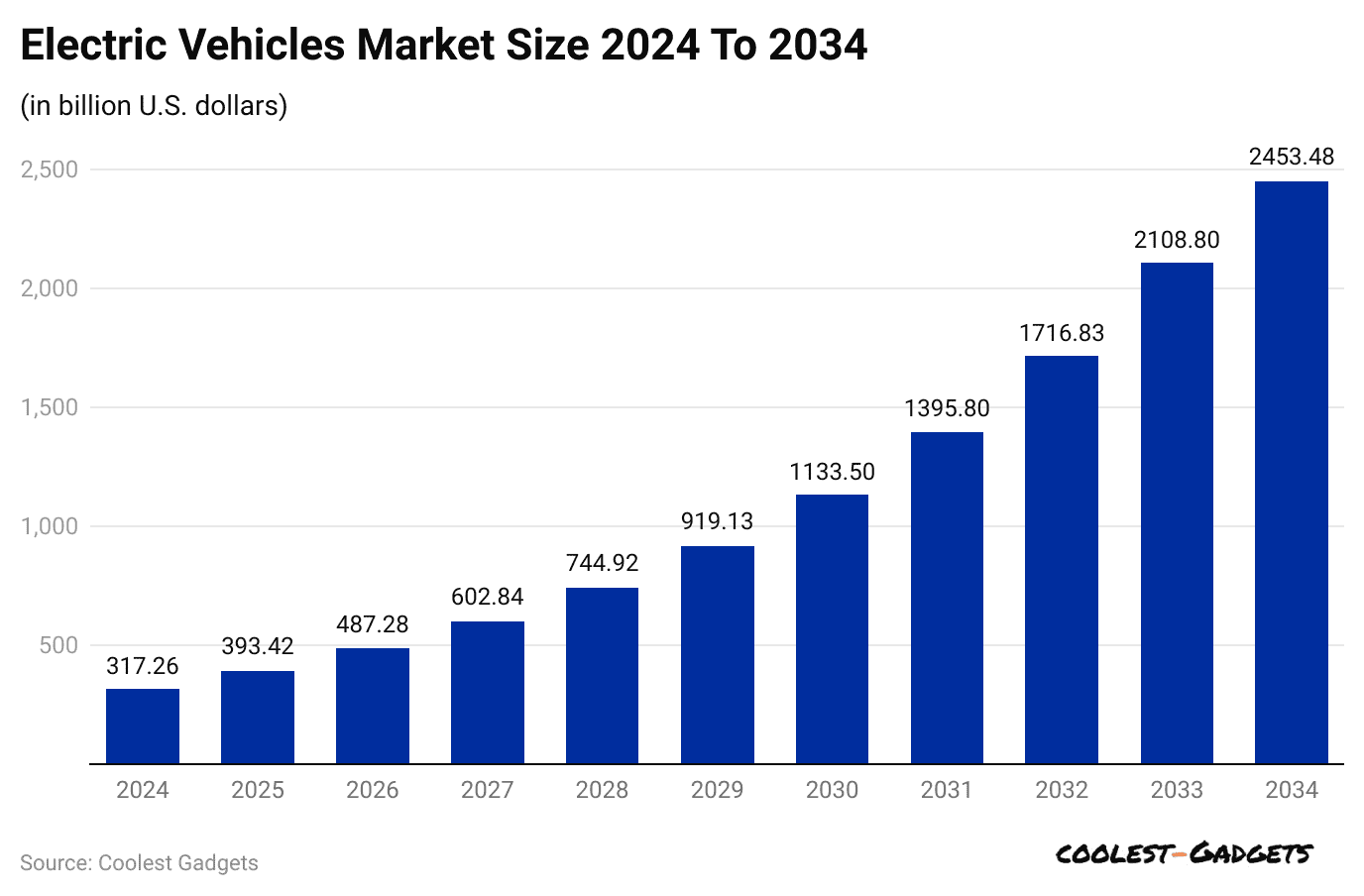 (Reference: precedenceresearch.com)
(Reference: precedenceresearch.com)
- In comparison, the market was valued at $260.63 billion in 2020. Thanks to increasing demand and better technology, the EV market is expected to grow fourfold by 2026.
- In 2020, electric vehicles could drive about 300 km (roughly 186 miles) on a single charge.
- Electric Vehicle Usage Statistics stated that with battery tech improving, the range will increase to 380 km by 2025 and reach 440 km by 2030. That’s a 46.67% increase over ten years.
- Last year, an estimated 12 million electric passenger cars were on the road worldwide, making up about 1% of all vehicles.
- According to the Global EV Outlook 2024, there are three future scenarios:
#1. Stated Policies Scenario (STEPS)
- Based on current government actions.
- Nearly 250 million EVs will be on the road by 2030
- 525 million by 2035
- Over 50% of new vehicle sales could be electric by 2035
#2. Announced Pledges Scenario (APS)
- Assumes countries meet their announced targets.
- 585 million EVs by 2035
- About 66% of all car sales will be electric
#3. Net Zero Emissions Scenario (NZE)
- Aims for zero emissions by 2050 and limits global warming to 1.5°C.
- 790 million EVs needed by 2035
- 95% of all car sales would need to be electric
#4. Europe’s Role
- Europe aims to hit 14 million EVs by 2025. By 2035, estimates suggest 85–95% of new car sales will be electric.
- After 2035, 100% of new vehicles sold in Europe are expected to be electric.
- By 2025, that number is expected to jump to 54 million, according to BloombergNEF.
- By 2027, more than half of all-electric vehicles will be built in Asia.
- Electric Vehicle Usage Statistics stated that China is projected to lead with 43.8% of global EV production.
- Japan and South Korea together are expected to produce another 11.6%.
- Europe is likely to account for 29.2% of all EVS, while North America is expected to make 11.6%.
- Together, these four regions are forecast to produce 96.2% of all-electric vehicles globally.
- Electric vehicles are becoming the go-to choice for new car buyers. Here’s how their popularity is expected to grow:
-
- By 2030, approximately 26% of new car sales will be electric.
- By 2040, that number could rise to 72.2%.
- And by 2050, around 81.5% of all vehicles sold are expected to be EVs.
Conclusion
Electric vehicle (EV) use is growing fast in 2025, with more people choosing EVs than ever before. In the U.S., approximately 1.7 million electric vehicles (EVs) were sold—up 21% from 2023. China, Europe, and the United States remain the top three markets for electric vehicles (EVs). Thanks to government programs like the Infrastructure Investment and Jobs Act and the Inflation Reduction Act, approximately $23 billion has been invested to boost electric vehicle (EV) and battery production.
Car companies are also transitioning to electric vehicles, setting ambitious goals for the future. Even though there are still issues, such as limited supplies and fluctuating prices of key minerals, EVs are expected to help reduce oil use by 6 million barrels per day by 2030. With improved technology and enhanced support, electric vehicles are becoming increasingly significant in everyday life worldwide. We have shed enough light on Electric Vehicle Usage Statistics through this article.
Sources
FAQ.
Electric vehicles accounted for roughly 18% of all car sales in 2023, up from 14% in 2022 and 2% in 2018. This shows that EV sales are still rising steadily as the market grows. In 2023, about 70% of all electric cars were fully battery-powered.
India’s electric vehicle (EV) industry is projected to experience rapid growth in the coming years. By 2030, the market could be worth around ₹20 lakh crore (about $240 billion). According to Nitin Gadkari, this rapid growth is expected to create nearly 50 million (5 crore) new jobs across the country.

Saisuman is a talented content writer with a keen interest in mobile tech, new gadgets, law, and science. She writes articles for websites and newsletters, conducting thorough research for medical professionals. Fluent in five languages, her love for reading and languages led her to a writing career. With a Master’s in Business Administration focusing on Human Resources, Saisuman has worked in HR and with a French international company. In her free time, she enjoys traveling and singing classical songs. At Coolest Gadgets, Saisuman reviews gadgets and analyzes their statistics, making complex information easy for readers to understand.











